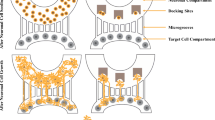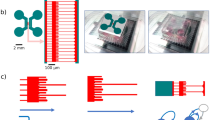Abstract
In this work, the formation of functional synapses between compartmentalized cortical neurons cultured inside three-compartment microfluidic devices in a controlled fashion is described. The proposed device can direct axons in an isolated compartment and, thus, facilitates isolated axons forming functional synapses with dendrites of other neurons in an isolated microenvironment. This microfluidic approach allows continuous real-time monitoring of neuronal processes and fluorescently tagged biomolecules involved in synapse formation, and provides an easy, simple, cost effective, and efficient method to develop and manipulate synapses in an isolated microenvironment without using surface patterning techniques or electrical stimulation. The results presented here suggest that this microfluidic approach could be used as an alternative method for the formation of functional synapses and their exhaustive examinations.
Similar content being viewed by others
References
Cohen-Cory, S. The developing synapse: construction and modulation of synaptic structures and circuits. Science 298, 770–776 (2002).
Ferreira, A. & Paganoni, S. The formation of synapses in the central nervous system. Mol. Neurobiol. 26, 69–79 (2002).
Garner, C.C., Zhai, R.G., Gundelfinger, E.D. & Ziv, N.E. Molecular mechanisms of CNS synaptogenesis. Trends Neurosci. 25, 243–250 (2002).
Thompson, S.M. Matching at the synapse. Science 308, 800–801 (2005).
Kostyuk, P.G. Key role of calcium signaling in synaptic transmission. Neurophysiol. 39, 248–250 (2007).
Zucker, R.S. Calcium- and activity-dependent synaptic plasticity. Curr. Opin. Neurobiol. 9, 305–313 (1999).
Smith, S.M., Renden, R. & von Gersdorff, H. Synaptic vesicle endocytosis: fast and slow modes of membrane retrieval. Trends Neurosci. 31, 559–568 (2008).
Choquet, D. & Triller, A. The role of receptor diffusion in the organization of the postsynaptic membrane. Nat. Rev. Neurosci. 4, 251–265 (2003).
Richards, D.A., Bai, J. & Chapman, E.R. Two modes of exocytosis at hippocampal synapses revealed by rate of FM1-43 efflux from individual vesicles. J. Cell Biol. 168, 929–939 (2005).
Wolff, J.R., Laskawi, R., Spatz, W.B. & Missler, M. Structural dynamics of synapses and synaptic components. Behav. Brain Res. 66, 13–20 (1995).
Akins, M.R. & Biederer, T. Cell-cell interactions in synaptogenesis. Curr. Opin. Neurobiol. 16, 83–89 (2006).
Balena, T., Acton, B.A., Koval, D. & Woodin, M.A. Extracellular potassium regulates the chloride reversal potential in cultured hippocampal neurons. Brain Res. 1205, 12–20 (2008).
Mammen, A.L., Huganir, R.L. & O’Brien, R.J. Redistribution and stabilization of cell surface glutamate receptors during synapse formation. J. Neurosci. 17, 7351–7358 (1997).
Tardin, C., Cognet, L., Bats, C., Lounis, B. & Choquet, D. Direct imaging of lateral movements of AMPA receptors inside synapses. EMBO J. 22, 4656–4665 (2003).
Sutton, M.A., Taylor, A.M., Ito, H.T., Pham, A. & Schuman, E.M. Postsynaptic decoding of neural activity: eEF2 as a biochemical sensor coupling miniature synaptic transmission to local protein synthesis. Neuron 55, 648–661 (2007).
Chronis, N., Zimmer, M. & Bargmann, C.I. Microfluidics for in vivo imaging of neuronal and behavioral activity in Caenorhabditis elegans. Nat. Methods 4, 727–731 (2007).
Tourovskaia, A., Figueroa-Masot, X. & Folch, A. Longterm microfluidic cultures of myotube microarrays for high-throughput focal stimulation. Nat. Protoc. 1, 1092–1104 (2006).
Yang, I.H., Siddique, R., Hosmane, S., Thakor, N. & Höke, A. Compartmentalized microfluidic culture platform to study mechanism of paclitaxel-induced axonal degeneration. Exp. Neurol. 218, 124–128 (2009).
Liu, W.W., Goodhouse, J., Jeon, N.L. & Enquist, L.W. A microfluidic chamber for analysis of neuron-to-cell spread and axonal transport of an alpha-herpesvirus. PLoS One 3, e2382 (2008).
Taylor, A.M. et al., Microfluidic multicompartment device for neuroscience research. Langmuir 19, 1551–1556 (2003).
Rhee, S.W. et al., Patterned cell culture inside microfluidic devices. Lab Chip 5, 102–107 (2005).
Ling, Y. et al., A cell-laden microfluidic hydrogel. Lab Chip 7, 756–762 (2007).
Peterman, M.C. et al., The artificial synapse chip: a flexible retinal interface based on directed retinal cell growth and neurotransmitter stimulation. Artif. Organs 27, 975–985 (2003).
Peterman, M.C., Noolandi, J., Blumenkranz, M.S. & Fishman, H.A. Localized chemical release from an artificial synapse chip. Proc. Natl. Acad. Sci. USA 101, 9951–9954 (2004).
Yoshimi, Y., Shinoda, K., Mishima, M., Nakao, K. & Munekane, K. Development of an artificial synapse using an electrochemical micropump. J. Artif. Organs 7, 210–215 (2004).
Ma, W. et al., Central neuronal synapse formation on micropatterned surfaces. Brain Res. Dev. Brain Res. 111, 231–243 (1998).
O’shaughnessy, T.J., Lin, H.J. & Ma, W. Functional synapse formation among rat cortical neurons grown on three-dimensional collagen gels. Neurosci. Lett. 340, 169–172 (2003).
Denny, J.B. MAP5 in cultured hippocampal neurons: expression diminishes with time and growth cones are not immunostained. J. Neurocytol. 20, 627–636 (1991).
Taylor, A.L. & Hewett, S.J. Potassium-evoked glutamate release liberates arachidonic acid from cortical neurons. J. Biol. Chem. 277, 43881–43887 (2002).
Dai, Z. & Peng, H.B. Fluorescence microscopy of calcium and synaptic vesicle dynamics during synapse formation in tissue culture. Histochem. J. 30, 189–196 (1998).
Hall, B.J. & Ghosh, A. Regulation of AMPA receptor recruitment at developing synapses. Trends Neurosci. 31, 82–89 (2008).
Bannai, H., Lévi, S., Schweizer, C., Dahan, M. & Triller, A. Imaging the lateral diffusion of membrane molecules with quantum dots. Nat. Protoc. 1, 2628–2634 (2006).
Author information
Authors and Affiliations
Corresponding author
Rights and permissions
About this article
Cite this article
Mahto, S.K., Song, Hs. & Rhee, S.W. Functional synapse formation between compartmentalized cortical neurons cultured inside microfluidic devices. BioChip J 5, 289–298 (2011). https://doi.org/10.1007/s13206-011-5401-z
Received:
Accepted:
Published:
Issue Date:
DOI: https://doi.org/10.1007/s13206-011-5401-z




